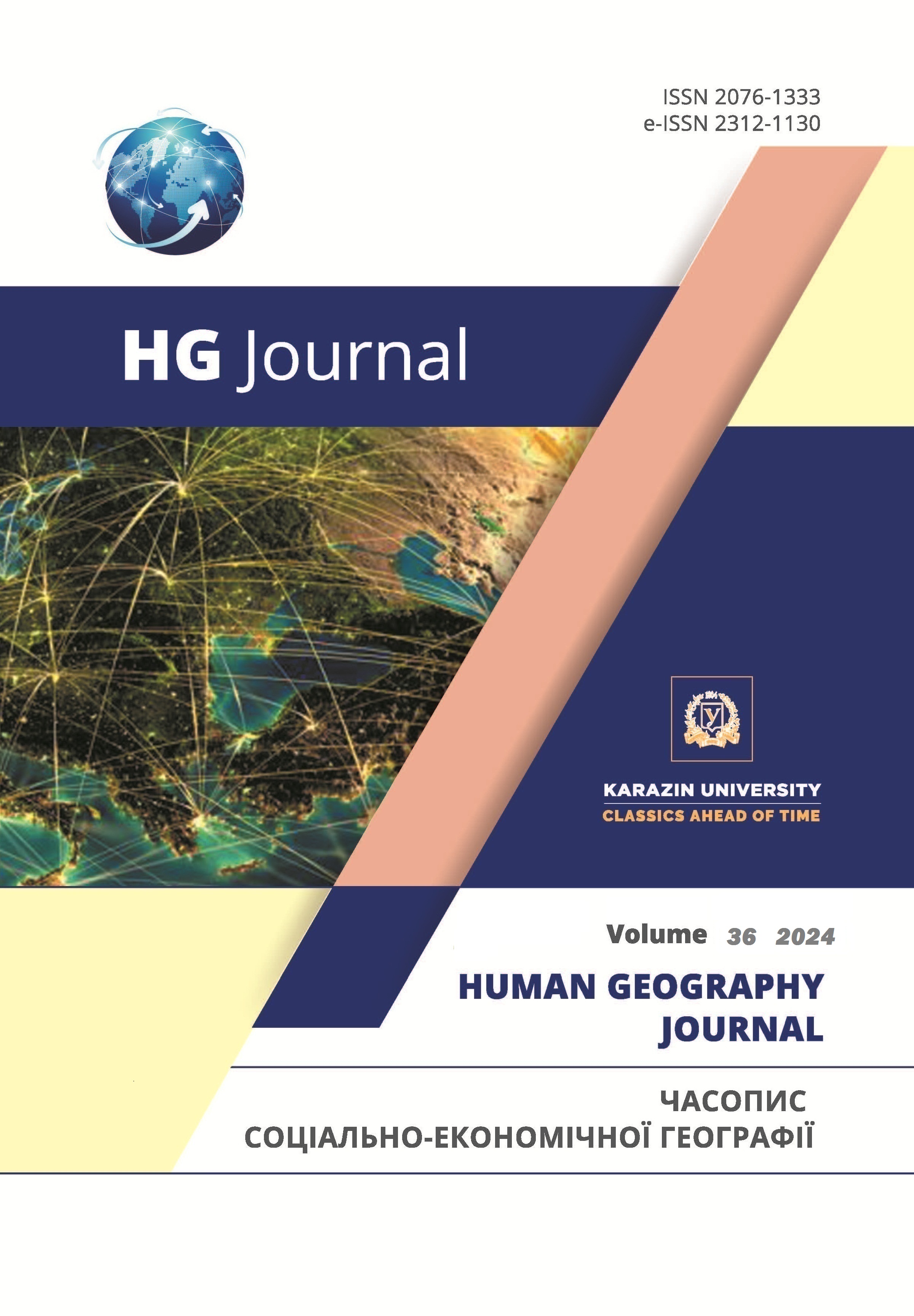Військовий урбіцид проти України
Анотація
У статті розглядається феномен «урбіциду» або цілеспрямованого знищення міст як актуальна проблема у сучасних зонах конфлікту, зосереджується увага на його появі у сучасних конфліктах, зокрема в українському Харкові через військову агресію росії. У дослідженні підкреслюється руйнівний вплив урбіциду на цивільне населення, міський ландшафт, соціальну, транспортну та критичну інфраструктуру міста, його культурну спадщину. Дослідження підкреслює необхідність мультидисциплінарного підходу, особливо через призму суспільної географію, щоб зрозуміти причини та наслідки урбіциду та визначити шляхи відновлення постраждалих міст.
Авторами наголошується на тому, що незважаючи на територіальну локалізацію цього явища, його наслідки мають далеку перспективу та вплив на всю світову спільноту, що вимагає міжнародного втручання та підтримки, гуманітарної допомоги та стратегій для відновлення постраждалих міст і запобігання майбутнім кризам, наголошуючи на глобальній безпеці та економічних наслідках урбіциду.
У статті вивчаються та аналізуються просторові аспекти та наслідки урбіциду, представлений комплексний аналіз його етапів та форм, досліджуються географічні особливості та визначаються соціально-економічні наслідки на території міста Харків. Автори зазначають, що урбіцид використовувався російськими військовими як стратегічний і маніпулятивний інструмент. У дослідженні розглядаються три основні сценарії урбіциду, які спостерігалися в Україні, зокрема Донецький, Маріупольській та Харківський, де російська тактика варіювалася від вибіркового терору до широкомасштабного знищення. Дослідження визначає, як урбіцид виходить за межі фізичного знищення, впливаючи на психічне благополуччя населення, і демонструє, як регіональні фактори, такі як близькість до активної лінії фронту, підвищують вразливість до урбіциду.
Автори наголошують на тому, що урбіцид залишається інструментом ведення війни з далекосяжними соціально-економічними наслідками, що вимагає реакції світової спільноти на підтримку післявоєнної реконструкції міст і запобігання подальшій міжнародній нестабільності.
Завантаження
Посилання
Larin, Yu. (2023). Shkola v metro: Yak navchatymutsia dity pid zemleiu v Kharkovi [School in the subway: How children will study underground in Kharkiv]. Dumka. Retrieved from https://dumka.media/ukr/suspilstvo/1693573223-shkola-v-metro-yak-navchatimutsya-diti-pid-zemleyu-v-harkovi [in Ukrainian].
Mariupolskyi dramteatr: rik potomu. Realnyi zlochyn ta strashni feiky rashyzmu [Mariupol Drama Theater: a year later. Real crime and terrible fakes of rashism]. Tsentr stratehichnykh komunikatsii ta informatsiinoi bezpeky (2023, March 15). Hlavkom. Retrieved from https://glavcom.ua/publications/mariupolskij-dramteatr-rik-potomu-realnij-zlochin-ta-strashni-fejki-rashizmu-914675.html [in Ukrainian].
Mykhailova, O. (2022). Urbitsyd – stratehiia rosiiskykh okupantiv v rosiisko-ukrainskii viini [Urbicide is the strategy of the Russian occupiers in the Russian-Ukrainian war]. Natsionalnyi instytut stratehichnykh doslidzhen. Retrieved from https://niss.gov.ua/news/komentari-ekspertiv/urbitsyd-stratehiya-rosiyskykh-okupantiv-v-rosiysko-ukrayinskiy-viyni
[in Ukrainian].
Nedilko, K. (2023). U Kharkovi ta oblasti nazvaly raiony, yaki naibilshe postrazhdaly vid viiny [In Kharkiv and the region, the districts most affected by the war were named]. Comments.ua. Retrieved from https://kharkov.comments.ua/ua/news/war/2023/23083-u-harkovi-ta-oblasti-nazvali-rayoni-yaki-naybilshe-postrazhdali-vid-viyni.html [in Ukrainian].
Pisliavoienne vidnovlennia Ukrainy: yaki krainy vzialy shefstvo nad mistamy ta oblastiamy [Post-war reconstruction of Ukraine: which countries took over cities and regions]. (2023). Slovo i Dilo. Retrieved from https://www.slovoidilo.ua/2023/03/01/infografika/suspilstvo/pislyavoyenne-vidnovlennya-ukrayiny-yaki-krayiny-vzyaly-shefstvo-nad-mistamy-ta-oblastyamy [in Ukrainian].
Tudy pryishov «ruskyi myr»: yaki mista Ukrainy buly povnistiu abo chastkovo zruinovani pid chas viiny [The "Russian peace" came there: which cities of Ukraine were completely or partially destroyed during the war] (2023). Slovo i dilo. Retrieved from https://www.slovoidilo.ua/2023/02/03/infografika/suspilstvo/tudy-pryjshov-ruskyj-myr-yaki-mista-ukrayiny-buly-povnistyu-abo-chastkovo-zrujnovani-vijny [in Ukrainian].
KharkivToday (2022). Kharkivski pereselentsi. Skilky yikh rozkydano po Ukraini [Kharkiv settlers. How many of them are scattered across Ukraine]. Retrieved from https://2day.kh.ua/ua/kharkow/kharkivski-pereselentsi-skilky-yikh-rozkydano-po-ukrayini [in Ukrainian].
Apostvof (2024). Yak zaraz vyhliadaie zruinovana TETs u Kharkovi: foto [What the destroyed CHP in Kharkiv looks like now: photo]. Retrieved from https://apostrophe.ua/ua/news/society/2024-03-26/kak-seychas-vyiglyadit-razrushennaya-tets-v-harkove-foto/317304 [in Ukrainian].
Appadurai, A. (1996). Modernity at large: Cultural dimensions of globalization (Vol. 1). London: University of Minnesota Press [in Ukrainian].
Clements-Hunt, А. (2022, June 07). Russia’s Campaign of Urbicide in Ukraine. New Lines Institute. Retrieved from https://newlinesinstitute.org/rules-based-international-order/russias-campaign-of-urbicide-in-ukraine/
Convention on the Prevention and Punishment of the Crime of Genocide. United Nations. United Nations Human Rights Office Of The High Commissioner. Retrieved from https://www.ohchr.org/en/instruments-mechanisms/instruments/convention-prevention-and-punishment-crime-genocide
Coward, M. (2010). Urbicide: The Politics of Urban Destruction By Martin Coward. Global Discourse, 1(2), 186-189. https://doi.org/10.1080/23269995.2010.10707864
Exploring the future of the “Century of the city” (2012). United Nations Economic Commission for Europe. Retrieved from https://unece.org/press/exploring-future-century-city
Gutiérrez-Sanín, F., & Wood, E.J. (2017). What Should We Mean by "Pattern of Political Violence"? Repertoire, Targeting, Frequency, and Technique. Perspectives on Politics, 15(1), 20-41. https://doi.org/10.1017/S1537592716004114
Graham, S. (2004). Introduction: Cities, warfare, and states of emergency. In: S. Graham (ed.), Cities, war, and terrorism: Towards an urban geopolitics. Oxford: Blackwell Publishing, p. 1-25.
Hoy, D. (2012). Urbicidio: la violencia urbana. Retrieved from https://works.bepress.com/fernando_carrion/522/
Lawrence, J.Ch. (2018). Urbicide: the killing of a city is an attack on the human condition. City Monitor. Retrieved from https://citymonitor.ai/environment/urbicide-killing-city-attack-human-condition-3617
Malchykova, D., & Pylypenko, I. (2022). Occupation urbicide: urban experience and everyday practices of the population (a case of Kherson, Ukraine). Ekonomichna ta Sotsialna Geografiya, 88, 6-15. Retrieved from https://doi.org/10.17721/2413-7154/2022.88.6-15
Mezentsev, K. & Mezentsev, O. (2022). War and the city: Lessons from urbicide in Ukraine. Czasopismo Geograficzne, 93(3), 495-521. Retrieved from https://doi.org/10.12657/czageo-93-20
Safier, M. (2001). Confronting “Urbicide”: Crimes Against Humanity, Civility and Diversity and the Case for a Civic Cosmopolitan Response to the Attack on New York’. City. 5:3, 416-429.
Sharp, D. (2016). Urbicide and the Arrangement of Violence in Syria. Beyond the Square: Urbanism and the Arab Uprisings. Pub-lisher: Urban Research, 118-140.
Shaw, M. (2008). New Wars of the City: Relationships of “Urbicide” and “Genocide”. Cities, War, and Terrorism: Towards an Urban Geopolitics, 141-153.
State of the World’s Cities 2008/2009. Harmonious Cities. London: Sterling, VA. Retrieved from https://sustainabledevelopment.un.org/content/documents/11192562_alt-1.pdf
Stathis Kalyvas (2006). The Logic of Violence in Civil War. Cambridge: Cambridge University Press.
Straus, S. (2012). “Destroy Them to Save Us”: Theories of Genocide and the Logics of Political Violence. Terrorism and Political Violence, 24(4), 544-560. https://doi.org/10.1080/09546553.2012.700611
Woodward, R. (2005). From Military Geography to militarism’s geographies: disciplinary engagements with the geographies of militarism and military activities. Progress in Human Geography, 29(6), 718-740. Retrieved from https://doi.org/10.1191/0309132505ph579oa
Wright, J.L. (2016). Urbicide: The Ritualized Killing of Cities in the Ancient Near East, in Saul M. Olyan (ed.), Ritual Violence in the Hebrew Bible: New Perspectives. New York, online edn, Oxford Academic.
Авторське право (c) 2024 Ключко Л., Бедрій Є., Хабусєв Є.

Цю роботу ліцензовано за Міжнародня ліцензія Creative Commons Attribution 4.0.




